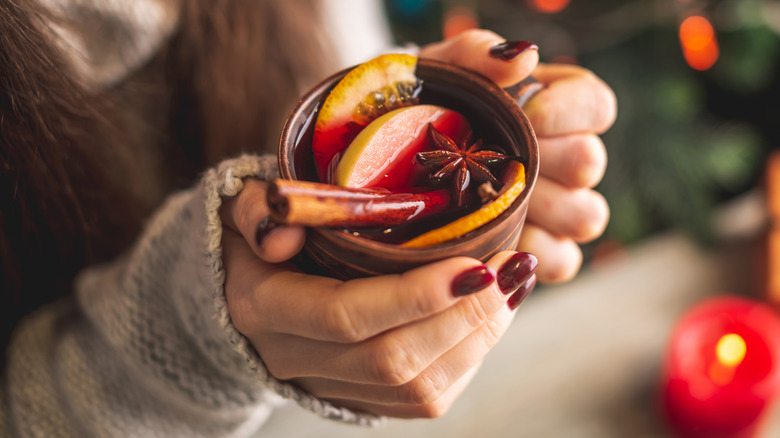Mulled Wine Vs. Glögg: What's The Difference?
Chestnuts for roasting, corn for popping, and all things baking-related are among the ingredients you'll see shoppers reaching for during the holiday season. As the nights grow shorter, our recipes get warmer and boozier, and with cold winter weather comes the incorporation of hard beverages and cozy spices into all kinds of recipes to ward off the chill. A traditional favorite is mulled wine, which fills the home with a sweet and inviting aroma. But during this most special time of year, you may also encounter glögg (pronounced "glug," per Merriam-Webster), a spiced drink which is similar to mulled wine.
According to The Wall Street Journal, mulled wine had medicinal origins in ancient Greece and Rome before becoming renowned throughout Europe. It certainly helps weather winter storms! Glögg, on the other hand, is particularly popular in the Nordic countries including Denmark, Finland, Iceland, Norway, and Sweden, and is likewise eagerly imbibed while awaiting Christmas, per Forbes. Nowadays, these beverages are as part of wintertime festivities as eggnog. Here's how they differ, how to make them, and how to enjoy them best.
The difference between mulled wine and glögg
Both mulled wine and glögg involve stoves, spices, and spirits, but mulled wine takes less time and requires fewer ingredients than glögg. Mulled wine begins with a base of decent red wine and the so-called "mulling spices": cinnamon, ginger, cloves, and star anise, sometimes with orange or lemon. It gets sweetened, simmered to perfection, and served warm: It goes down easy, by the mugful, with a holiday meal like orange clove baked ham, or sipped as you wind down and watch the snow fall. The spices double as a festive garnish when you're done. The New York Times recommends using a semi-dry, slightly fruity red and perhaps a splash of brandy. You can make mulled wine ahead of time in a slow cooker (per Food Network) to save valuable stove space for cooking.
Glögg might just be the thing you need to kindle some holiday cheer. Swedish Food says it's a must-have for celebrating Christmas season — Swedes even have dedicated glögg parties! While it contains similar spices as mulled wine, glögg recipes can also call for cardamom, raisins, and blanched almonds. Forbes writes that recipes can vary — in addition to red wine, port is often used along with vodka, brandy, cognac, or aquavit. Families pass down their special recipes. Glögg is traditionally (and wisely) served in little glasses, SwedishFood.com reports — and the raisins and nuts go in the glass first when you serve the drink. Many sources, including Edible Brooklyn, recommend aging glögg for the best flavor.
Cooking with mulled wine
Mulled wine and glögg are made to be enjoyed in good company, and taste amazing on their own. But the rich depth of flavor created by the spiced spirits is wonderful to add to your cooking. Make Food Network's mulled wine cranberry sauce to accompany your dinnertime roast, and BBC Good Food's mulled wine brownies to end the night on a sweet note. Don't forget to bake traditional Swedish gingersnaps (pepparkakor), to pair with your glögg. A similar make-ahead mulled beverage is mulled, infused whiskey, which you can drink on its own or add to your eggnog.
Mulled wine is an easy way to get the party started and make your home smell better than the best Yankee candle. Making your glögg with loved ones ahead of time when the sweaters start coming out of storage is fun, and you'll have something amazing to enjoy in the dead of winter. No need to mull it over: With both recipes under your belt, you'll know just how to utilize wine, spirits, and spices to stoke the holiday spirit.


